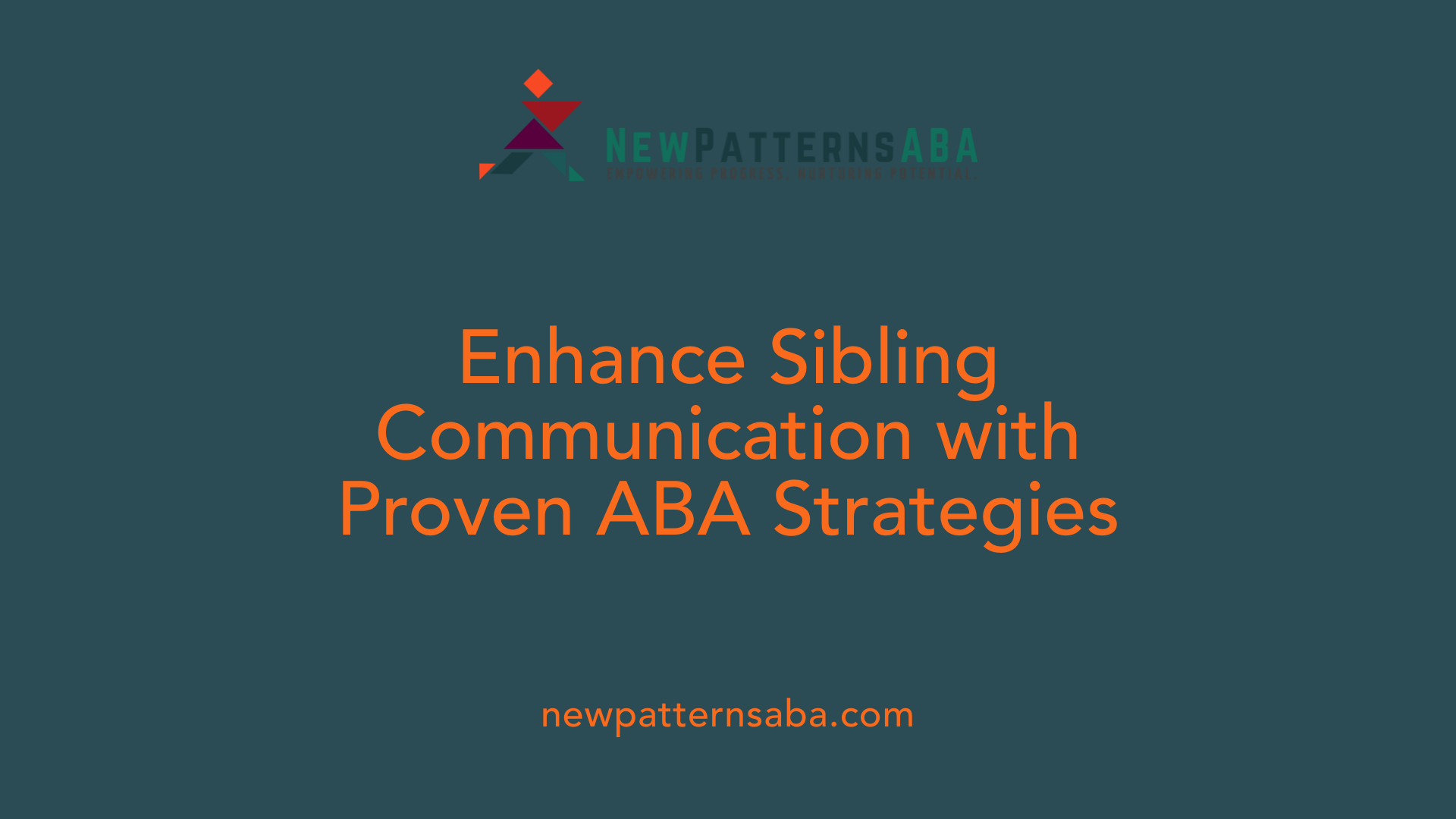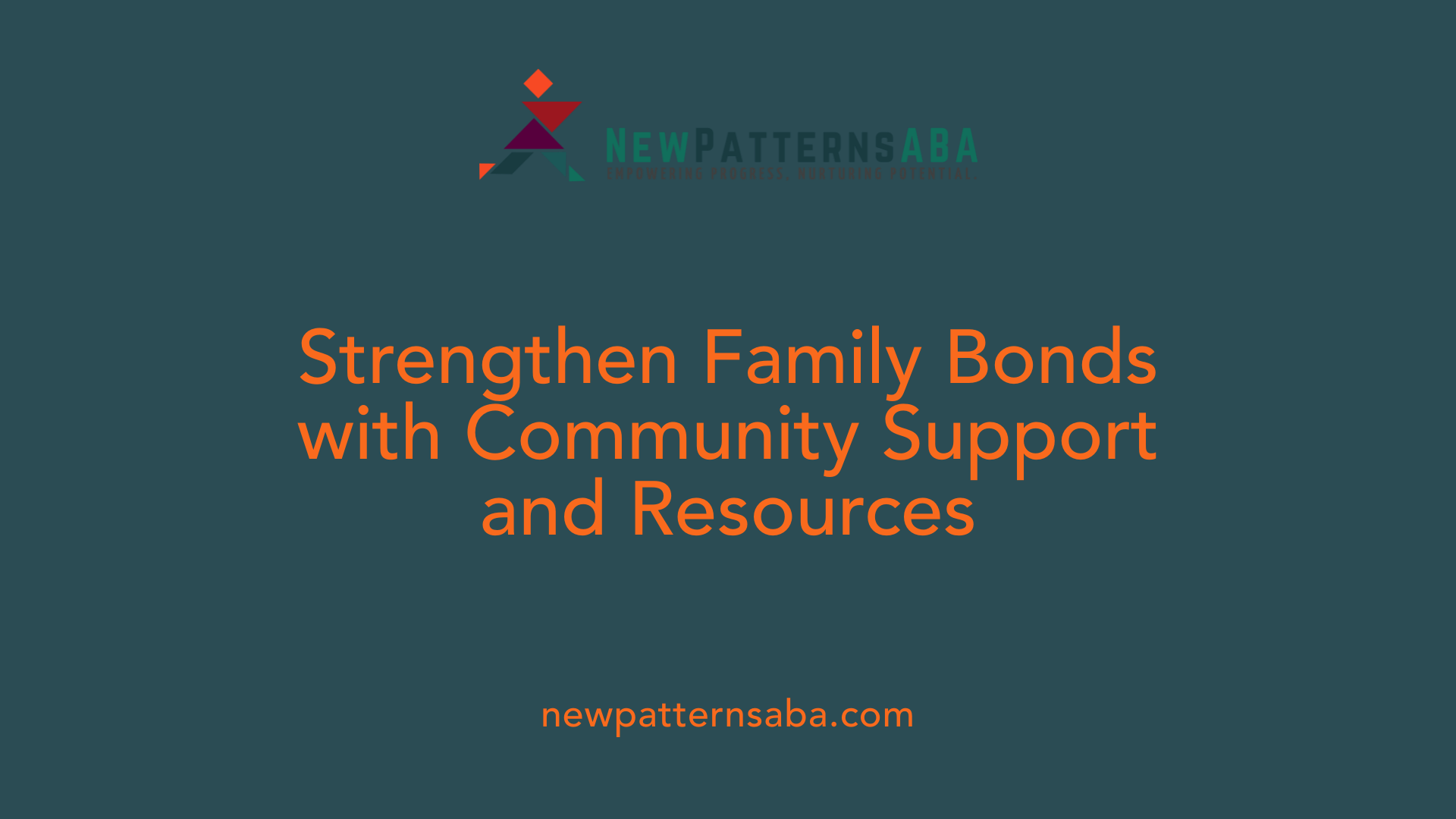Understanding the Impact of ABA on Family Relationships
ABA therapy is more than a behavioral intervention for children with autism; it is a tool that can transform family dynamics and strengthen sibling bonds. When implemented with family involvement, ABA promotes empathy, effective communication, and shared understanding, creating a nurturing environment where every family member feels supported and valued. This article explores how ABA therapy supports a harmonious home life by fostering better sibling interactions and building lasting relationships.
Enhancing Family Cohesion Through ABA Therapy
How does ABA therapy support a harmonious home environment through family involvement?
ABA therapy emphasizes the importance of family participation, which directly contributes to a more peaceful and supportive household. When parents and siblings are actively engaged in the process, they gain a clearer understanding of the child's behaviors and needs. This understanding helps foster empathy and patience, reducing misunderstandings and conflicts.
Parents are often trained in ABA techniques, enabling them to reinforce positive behaviors at home consistently. This regular reinforcement ensures that skills learned during therapy sessions are generalized to everyday life, which enhances the child's development and promotes behavioral stability.
Involving family members in routines and therapy activities creates a sense of teamwork. It fosters shared responsibility, encouraging cooperation among siblings and parents alike. Consistent communication with therapists allows families to adapt strategies to suit their specific circumstances, further supporting the child's growth.
Emotional support within the family, facilitated by collective efforts, nurtures a caring environment. Such an environment helps children feel secure and motivated, which can reduce behavioral issues.
Overall, active family involvement in ABA not only accelerates behavioral improvements but also strengthens family bonds. It creates a unified front where every member understands their role in creating a nurturing and harmonious home atmosphere.
Strategies for integrating ABA into daily routines
- Embedding reinforcement strategies into everyday activities.
- Using structured routines and visual supports to create predictability.
- Involving siblings in simple therapy tasks or shared play.
- Regular family check-ins to discuss progress and challenges.
The role of parent training in fostering harmony
- Teaching parents effective communication and positive reinforcement techniques.
- Guiding parents to manage behavioral challenges calmly and consistently.
- Encouraging parents to model emotional regulation and patience.
- Supporting parents in balancing attention among all children to prevent jealousy or rivalry.
By adopting these approaches, families can foster a positive, structured, and cohesive environment that benefits all members, especially the child undergoing ABA therapy.
Fostering Empathy and Understanding Among Siblings

How does ABA therapy influence family dynamics and sibling interactions?
ABA therapy plays an important role in improving family relationships, especially among siblings. By involving family members in therapy sessions and training, parents and siblings gain a clearer understanding of autism and the child's unique needs. These efforts help siblings develop empathy and supportive behaviors, which are crucial for creating a positive family environment.
Participating in therapy sessions allows siblings to observe and sometimes engage in supportive activities like turn-taking, role-playing, and shared play. Such structured activities promote cooperation and social skill development among siblings. When children with autism learn new communication and social skills, it becomes easier for the entire family to connect and interact meaningfully.
Family routines and shared activities, such as family meals or game nights, further strengthen sibling bonds. Integrating siblings into family routines creates a sense of teamwork and shared responsibility. Support groups for neurotypical siblings provide a peer-sharing platform where they can express feelings, ask questions, and reduce feelings of isolation.
By fostering understanding through education and inclusive activities, ABA therapy helps dispel misconceptions, reduces family stress, and promotes a supportive, resilient environment. This holistic approach encourages open communication, which is essential for managing challenges and celebrating successes together. Overall, ABA therapy not only supports the child's development but also nurtures healthier, more empathetic sibling and family relationships.
Strategies to Improve Sibling Communication with ABA Techniques

What strategies are used in ABA therapy to promote better sibling communication?
ABA therapy offers a variety of approaches to foster healthier and more supportive communication among siblings. Central to these strategies are social skills training, positive reinforcement, and modeling. These methods not only enhance interaction but also teach children appropriate ways to share, communicate, and resolve conflicts.
Social skills training involves teaching children specific behaviors like turn-taking, active listening, and sharing. Through role-playing exercises, siblings learn how to navigate everyday interactions with patience and empathy. These exercises also highlight the importance of emotional regulation, helping siblings understand and respect each other's feelings.
Involving siblings directly in therapy sessions can significantly strengthen bonds. During joint activities, they observe and participate alongside their brother or sister, which encourages understanding and cooperation. This shared experience builds empathy and creates opportunities for siblings to support each other.
Using visual aids and modeling desired behaviors are effective techniques in ABA. For example, demonstrating calm communication during disagreements or showcasing patience through videos or live examples helps children internalize these positive behaviors.
Active listening and clear communication are emphasized to minimize misunderstandings. Teaching siblings to listen attentively and respond respectfully nurtures a positive environment conducive to cooperation.
Another essential element is emotional intelligence. ABA encourages creating safe spaces for children to express their feelings, which fosters empathy and emotional resilience. Siblings learn to recognize and validate each other's emotions, reducing frustration and conflict.
Parental involvement also plays a vital role. Parents are guided to reinforce positive behaviors, utilize praise effectively, and establish consistent routines that mirror therapy principles. This integration promotes a healthy, supportive family dynamic.
Ultimately, the combination of structured skill-building activities, modeling, reinforcement, and family involvement helps create a family culture of understanding, patience, and emotional connection. Such an environment encourages siblings to develop supportive relationships that last beyond the therapy sessions.
Building Support Networks and Community Resources

What are the benefits of ABA therapy in improving sibling bonds?
ABA therapy plays a critical role in strengthening sibling relationships by fostering understanding, empathy, and positive interactions. As children with autism learn social and communication skills through ABA, their neurotypical siblings also gain insight into autism, which reduces confusion and promotes empathy.
Including siblings in therapy sessions or family activities offers opportunities for shared experiences and teamwork. This involvement encourages siblings to take on supportive roles, such as modeling positive behaviors or participating in routines together. These activities promote cooperation, patience, and mutual respect.
ABA's structured approach introduces routines and reinforcement techniques that help siblings develop supportive and respectful behaviors like sharing and turn-taking. Such practices enhance overall family harmony and create a nurturing environment.
Support networks extend beyond individual families. Family support groups and sibling-specific avenues provide emotional backing, normalize shared experiences, and foster resilience. These groups allow siblings to connect with peers, share challenges, and celebrate progress.
Community resources—such as local therapy centers, advocacy organizations, and online forums—offer additional support and education. They facilitate access to training, therapy options, and peer networks, which can make a meaningful difference in the long-term relationships within families.
Ultimately, collaborative efforts involving therapy, family routines, and community support help cultivate stronger sibling bonds and supportive family dynamics. This comprehensive approach not only benefits siblings but also enhances the quality of life for the entire family.
Creating a Supportive Family Environment with ABA Strategy

How can ABA therapy enhance sibling relationships at home?
ABA therapy plays a vital role in strengthening family dynamics, especially among siblings. By incorporating the principles of ABA into daily routines, families establish clear, consistent routines that provide predictability and security for all members. Structured activities like turn-taking games and shared play help improve social interactions and cooperation between siblings.
Educating neurotypical siblings about autism through ABA helps foster understanding and empathy. When siblings learn about autism in an age-appropriate way, it reduces confusion and promotes acceptance. Participating in therapy sessions or observing supportive behaviors reinforces positive interactions and teamwork.
Family involvement is crucial; involving siblings in family routines and therapy activities encourages shared responsibility and emotional bonding. Celebrating small successes, such as progress in social or communication skills, boosts morale and fosters motivation for continued growth.
Open communication and addressing challenges together create a positive atmosphere where siblings feel supported. Parental guidance that emphasizes calm communication and praise for positive behaviors nurtures a respectful and compassionate environment.
In sum, ABA therapy enhances sibling relationships by promoting mutual understanding, shared experiences, and supportive routines, leading to a more harmonious family life.
Building Emotional Resilience and Celebrating Progress
What are the benefits of ABA therapy in improving sibling bonds?
ABA therapy plays a vital role in strengthening relationships among family members, especially between siblings. Children with autism develop improved social and communication skills through positive reinforcement strategies used in ABA, making interactions more positive and engaging.
By involving siblings in therapy sessions and family routines, the bonds of understanding and empathy are nurtured. Educational efforts about autism help neurotypical siblings reduce confusion and foster compassion, creating a foundation of mutual respect.
Structured activities such as shared play, turn-taking, and cooperative exercises teach supportive behaviors like sharing, patience, and positive reinforcement. These activities encourage teamwork and shared responsibility, which enhance sibling relationships.
Support groups and family meetings also serve to provide emotional support, reduce feelings of isolation, and promote resilience among siblings. Overall, ABA encourages a family environment rooted in understanding, support, and shared growth.
How can celebrating milestones foster family resilience?
Celebrating small successes and milestones within ABA therapy nurtures a positive outlook and motivates continued progress. Recognizing these achievements creates a sense of shared pride and accomplishment, reinforcing the bond between family members.
Milestone celebrations can be simple, like a special family outing after a child's breakthrough in social skills, or more formal, like a family gathering acknowledging progress. These moments highlight collective effort and encourage ongoing support among siblings and parents.
Acknowledging achievements also reinforces patience and persistence, essential qualities for overcoming challenges together. It helps families view setbacks as opportunities for growth rather than failures.
Through these celebrations, families build resilience and emotional strength, cultivating an environment where everyone feels valued and motivated to continue working toward common goals.
How does shared achievement reinforce family pride?
Shared success stories foster strong family pride and reinforce a collective sense of achievement. When families celebrate milestones together, it emphasizes teamwork, patience, and resilience.
Supporting each other's efforts and recognizing individual and group progress strengthens emotional bonds. This shared experience builds a positive family culture rooted in encouragement and mutual support.
Ultimately, celebrating progress not only boosts motivation but also cultivates an inclusive environment where each family member feels responsible and engaged in the journey of growth and development.
Fostering Growth and Unity Through ABA
Implementing ABA therapy with active family participation can lead to profound improvements in sibling relationships, emotional well-being, and overall family harmony. By emphasizing open communication, empathy, and shared experiences, families can create a supportive environment where every member feels valued. Celebrating progress, addressing challenges collaboratively, and engaging in inclusive routines lay the groundwork for resilient, empathetic sibling bonds that last a lifetime. ABA not only facilitates developmental gains but also nurtures a unified, caring household that thrives on understanding and teamwork.
References
- Enabling Siblings to Understand and Bond with Their Autistic ...
- Empowering Siblings in the ABA Therapy Journey - Brightside ABA
- How Can You Support Siblings During Center-Based ABA?
- ABA Therapy and Its Impact on Family Dynamics
- The Impact of ABA on Families | Prospera Healthcare
- Help Siblings of Children with Autism Thrive - Strive ABA Consultants
- How ABA Therapy Supports Sibling Relationships in Families with ...
- Enabling Siblings to Understand and Bond with Their Autistic ...
- The Role of Caregiver Involvement in ABA Therapy
- Family-Centric Applied Behavior Analysis Facilitates Improved ...





